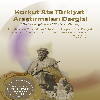ÇELİK ÇERÇEVELERİN FARKLI STOKASTİK YÖNTEMLER KULLANILARAK OPTİMUM BOYUTLANDIRILMASI
Optimum Design of Steel Frames Using Different Stochastic Techniques
___
- Arsan, T., 2018, “Büyük Patlama – Büyük Çöküş Optimizasyon Yöntemi Kullanılarak Bluetooth Tabanlı İç Mekan Konum Belirleme Sisteminin Doğruluğunun İyileştirilmesi”, Journal of Natural and Applied Sciences, Cilt 22, ss. 367-374.
- Aydoğdu, İ., Akın, A., Saka, M. P., 2016, “Design optimization of real World steel space frames using artificial bee colony algorithm with Levy flight distribution”, Advances in Engineering Software, Volume 92, pp. 1-14.
- Doğan, E., 2010, “Optimum Design Of Rigid and Semi-Rigid Steel Sway Frames Including SoilStructure Interaction”, Ph.D. Dissertation, Middle East Technical University, Ankara, Turkey, 262 p.
- Doğan, E. Saka, M. P., 2012, “Optimum design of unbraced steel frames to the LRFD-AISC code using particle swarm optimization”, Advances in Engineering Software,Volume 46, pp. 27–34.
- Erdem, R. T., 2015, “Non-linear performance analysis of existing and concentric braced steel structures”, Steel and Composite Structures, Volume19, Issue 1,pp. 59-74.
- Erol, O. K.,Eksin, I. A.,2006,“A new optimization method: Big Bang – Big Crunch”, Advances in Engineering Software, Volume 37, pp. 106–11.
- Gücüyen, E., Erdem, R. T., 2014, “Corrosion effects on structural behaviour of jacket type offshore structures”, Gradevinar, Volume 66, Issue 11, pp. 981-986.
- Kamal, O. El-Mahdy O., Nour, M. El-Komy, G., 2015,“Optimization of Steel Structures Using Particle Swarm Technique”, The Engineering and Scientific Research Journal,pp.1-14.
- Khalilporazari, S., Khalilporazari, Pasandideh, S. H. R., “Modeling and optimization of multi-item multiconstrained EOQ model for growing items”, Knowledge-Based Systems,Volume 164, pp. 150-162.
- Khalilporazari, S., Khalilporazari, S., “A lexicographic weighted Tchebycheff approach for multiconstrained multi-objective optimization ofthe surface grinding process”, Engineering Optimization, Volume 49, pp. 878-895.
- Kaveh, A. Abbasgholiha, H., 2011,“Optimum design of steel sway frames using Big Bang-Big Crunch algorithm”, Asian Journal of Civil Engineering,Volume 12, pp. 293-317.
- Kaveh, A., Bakhshpoori, T.,2013,“Optimum design of steel frames using Cuckoo Search algorithm with Levy flights”, Struct. Design Tall Spec. Build. Volume22, pp. 1023–1036.
- Kennedy, J., Eberhart, R., 1995, “Particle swarm optimization”,Proceedings of International Conference Neural Networks, Volume 4, pp. 1942-1948.
- LRFD-AISC Manual of Steel Construction, 2011,“Load and Resistance Factor Design”, 3rd Edition. American Institute of Steel Construction, USA.
- Oftadeh, R., Mahjoob, M.J., Shariatpanahi, M.,2010,“A novel meta-heuristic optimizationalgorithm inspired by group hunting of animals: Hunting search.” ComputersMathematics with Applications, Vol. 60, pp. 2087-2098.
- Reynolds, C., W., 1987, “Flocks, herds, and schools: A distributed behavioral model”, ACM Computer Graphics, Volume21, pp. 25–34.
- Saka, M. P., 2009,“Optimum design of steel sway frames to BS5950 using harmony search algorithm”, Journal of Constructional Steel Research, Volume 65, pp. 36-43.
- Saka, M. P.,Doğan, E.,Aydoğdu,İ.,2013,“Review and Analysis of Swarm-Intelligence Based Algorithms. Swarm Intelligence and Bio-Inspired Computation”, Theory and Applications, Chapter: 2. Ed: X-S Yang, Z Cui, R. Xiao, A. M. Gandomi, M. Karamanoğlu, Elsevier.
- SAP 2000 Analysis Reference Manual. Computers and Structures Inc., Berkeley
- Yayın Aralığı: Yılda 4 Sayı
- Yayıncı: Konya Teknik Üniversitesi, Mühendislik ve Doğa Bilimleri Fakültesi
Abdullah UYSAL, Hakan ÖZŞEN, Arif Emre DURSUN
TÜRKİYE’DE VE DÜNYADA ÇEVRE KORUMA HARCAMALARININ MUKAYESELİ DEĞERLENDİRMESİ
İzzet ÖZTÜRK, Hale ÖZGÜN, Büşra ÇİÇEKALAN
KONUTLARDA PAKET TİPİ KOJENERASYON İLE YERİNDE ENERJİ ÜRETİMİ – KONYA ŞARTLARINDA UYGULAMA
Mehmet KAPLAN, Mahmut Sami BÜKER
İNŞAAT ATIKLARININ YERALTI MADENİ ÜRETİM BOŞLUKLARINDA DOLGU MALZEMESİ OLARAK KULLANIMI
Tekin YILMAZ, Ferdi CİHANGİR, Bayram ERÇIKDI
NAFTALİN-BAĞLI MAKROHALKALI KOMPLEKSLERİN SENTEZİ VE SPEKTROSKOPİK DAVRANIŞLARININ İNCELENMESİ
GÜNEYDOĞU ANADOLU BÖLGESİNDEKİ İLLERİN KURAKLIK ANALİZİ
Selim DOĞAN, Şükrü DURSUN, Türker TUĞRUL
ÇELİK ÇERÇEVELERİN FARKLI STOKASTİK YÖNTEMLER KULLANILARAK OPTİMUM BOYUTLANDIRILMASI
Erkan DOĞAN, Aybike ÖZYÜKSEL ÇİFTÇİOĞLU
Ramazan ÜNLÜ, Ersin NAMLI, Ecem GÜL
